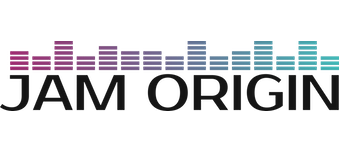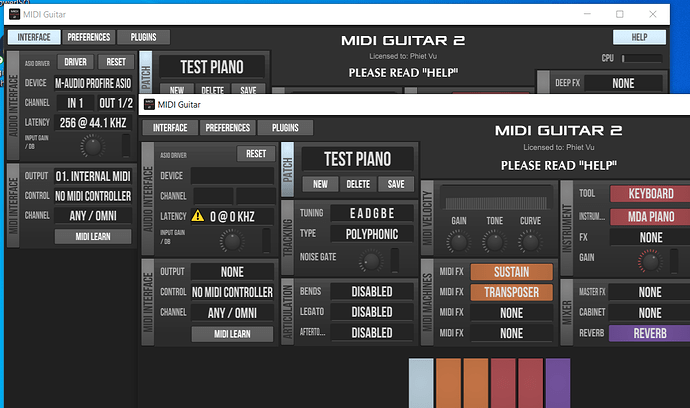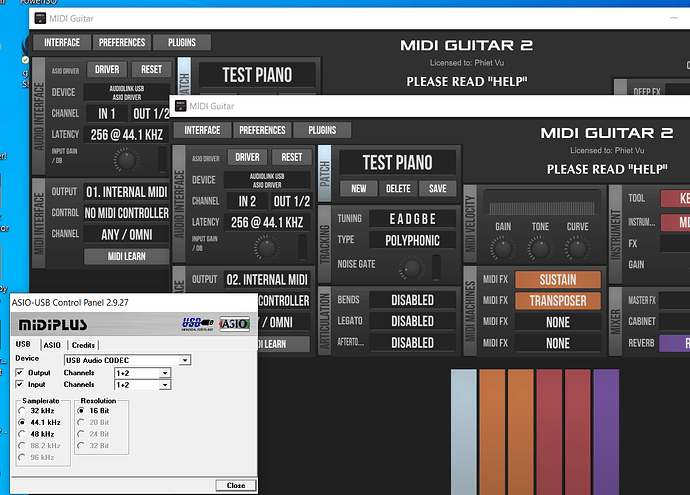Especially for VST / DAW where each instance do something different ?
yes, you can run multiple instances at the same time. But it is generally ionly usefull, when you feed different strings to different instances.
A stick player might use MB on one track and MG on another for the 2 string sections, or if you play doubleneck tapguitar, you can use 2 MG’s.
The normal way to get more sound from a normal guitar, is to load multiple synths on multiple DAW tracks, and let htem play along with 1 single MG instance.
Did you find though? That if you want to play in a different part on the VST, you have to change the MIDI channels away from MIDI Guitar2 on the previous VST in order for the new VST Midi Guitar 2 to record?
yes, ofcourse you can use “channel select” inside each MG plugin to adress different instruments on different tracks.
Most daw have a simple midi channel chooser on their instrument tracks: only logic is complicated.
Using trial, no vst.
I’m tying a setup for my 9-string Ibanez RG 9. (no djent… just finger style).
My current setup using pedals is to split input to 2 output, using a JHS 1-2 splitter. Each path is then process for bass and guitar sound separately - the guitar signal has a deep bass cut, before it’s driven by Roland SY 300 / some EHXs … then both signal is mixed back using a small pedal size mixer.
Trying to do something like that using DAW based setup.
Paul, am I interpreting your previous response correctly:
’
yes, you can run multiple instances at the same time. But it is generally ionly usefull, when you feed different strings to different instances.
’
Can I assign the 6th string of my guitar to Midi Bass, and the other 5 to Midi Guitar, so that I can play a bass line on the 6th string and a melody on the other 5 strings at the same time? I’m a potential customer and brand new to the forum, so I’d really appreciate any guidance on how to accomplish this, if it is possible.
Thanks much, Will
you can only do that if you have a separate pickup for the the 6th string, and another for the other five strings.
Oh, right. So I’d need a pickup with just the 6th string pole working, and another pickup with the 6th string pole not working, basically. And both pickups on a separate audio channel (two guitar cords). Makes sense. Thanks for your quick and expert response, Paul.
Hello friends.
Can I run 2 MIDIguitar2 at the same time?
I would like a setup like this:
_ SD-50 audio interface has 2 input ports and 2 output ports.
_I have a Loopbe 30 as a midi cable
MG 1 : In 1 midiout : loopbe 1
Next I run
MG 2 : In 2 midiout : loopbe2
Is this wish possible? Please guide me.
Thank you.
when i use multiple instances of mg2 i do so inside ableton. i have a hex pickup guitar and i have six copies of mg2 running, one per string.
using any daw will make routing easier i believe.
i don’t know what is possible with two copies running in standalone mode.
what you’d like may be possible without a daw.
can you provide more information: which vst instruments do you want to control, are you intending to split them across the fretboard? and what is it that you cannot do with a single instance only?
also which os are you running?
Hello friends.
Can I run 2 MIDIguitar2 at the same time?
I would like a setup like this:
_ SD-50 audio interface has 2 input ports and 2 output ports.
_I have a Loopbe 30 as a midi cable
MG 1 : In 1 midiout : loopbe 1
Next I run
MG 2 : In 2 midiout : loopbe2
Is this wish possible? Please guide me.
Thank you.
What exactly do you want to do? Using the MIDI data generated from one guitar input and split it to two different VST’s? You would not need two instances of MG2 running to do so. If you want to use more than one instance, e.g. with different inputs, you need to use a host application, in standalone mode only one instance can be active.
EDIT:
I have to correct myself. Just tried to use two standalone instances and it works. You could use two different inputs (2 guitars) for both instances running in parallel. MIDI output ports are selectable for each instance.
From what I’ve read, you intend to use 2 guitars, one in each input of your audio interface, gthen in each MG2 instance send the MIDI data to Loopbe30?
If so, this will work on Mac but on Windows you will need to use an asio multiclient driver to be able to use 2 instances at the same time.
First of all, let me apologize to everyone: mikyo, Dutti67,
Herold. I was late in replying to those of you who were concerned about me.
Because I don’t know how to use the forum, like where to reply, my English is very bad, I have to ask Google Tranlate for help.
I use Windows 10, I want to use a guitar to replace the keyboard running in the GIGLAD program to play YAMAHA styles in music…
_In GIGLAD you can play a note and it activates the program to play a rhythm with a certain chord you want. (1 midi out channel of MIDIGUITAR2 _I use 01 internal midi, I have “LOOPBE30”)
_So at the same time, with this guitar I play the melody of the song (I use another channel of MIDIGUITAR2: 02 internal midi also of “LOOPBE30”
When running 2 versions of MG2, it seems like there must be 2 audio interfaces, this is so annoying!!!
That is my dream, hope you can help me.
Thank you.
A single interface is all you need, since you have 2 inputs.
But as I said before, if your audio interface doesn’t have an asio multiclient driver, it won’t work.
To find out, can you use Giglad (configured with asio) and MG2 at the same time? If this doesn’t work, your interface supports only one asio application at a time.
In this case, you don’t need 2 audio interfaces, but you do need to install an asio multiclient driver, which allows you to use several applications at the same time with the same interface.
P.S.: I use DeepL instead of Google translate, have a look at it.
Translated with DeepL.com (free version)
Hello Herold, thank you for your help. Below is what I have experimented with. I have 3 audio interfaces.
1_M-audio profire 610 …driver asio. The result is not good. When running MG2 and add MG2 again…device does not receive M-audio profire.(pic 1)
2_SD-50 Roland sound canvas. also an asio driver… but the results are not good either.(pic 2)
And next
3_I have a cheap audio interface AUDIO LINK …diver asio… but the result is Good, it works on both MG2.(pic 3)
Please help me, explain what I need to know so I can buy an audio interface for good results. I wish I could use my guitar to play nylon guitar…saxophone…big VST… .
Thank you very much.
Dear Herold, I have sent the above content in an email to you, and I am writing it here so that many people can give their comments for fun…
Thank you for deepL.COM, I can’t use it because it doesn’t support the Vietnamese language
THANK YOU
In the first two images, in the DEVICE window, only one interface appears: this means that these interfaces do not have an asio multiclient driver, i.e. one that can use more than one application at the same time. Example for the SD-50, in the manual it says:
“Can’t select/use the SD-50 within software or in system settings - Could the SD-50 be in use by other software? Close all software you currently have running. Next, switch off the SD-50’s power, then turn it back on again.”
= Only one application.
On the other hand, AudioLink, although cheap, works well because it appears in both DEVICE windows.
-
First solution that costs nothing: you use Audiolink if it suits you and the problem is solved.
-
Second solution that costs nothing: if one of the other interfaces suits you, you install a free asio multiclient driver like ASIO4ALL to replace the drivers for your other two interfaces. The disadvantage of ASIO4ALL is that it has a bit of latency and is sometimes unstable. But depending on the computer and the program, it may work perfectly.
-
Third solution: you need to buy an interface. In this case, it must have an asio multiclient driver.
The problem is that this is never (or almost never) specified in the presentations or even in the user manuals of the devices, so you’ll have to search for this information.
Apart from this essential criterion, the choice of interface will depend on your needs: if you’re the only one using it, 2 mic/instrument inputs + 2 line inputs (to add a keyboard, recorder, etc.) will suffice.
If you intend to use a MIDI device equipped only with 5-pin DIN sockets, you’ll need to provide MIDI inputs/outputs on the interface.
Here’s what you need to know to make the right choice.
Personally, I started out with a Steinberger interface costing 120 euros, which suited me fine until the day I needed to use two applications at the same time… I now have an interface that has the features I’ve described (RME Babyface Pro) but costs €700 because I chose top-of-the-range equipment.
To make your choice, you can look for comparisons on the internet, for example :
9 Best Audio Interfaces Under $500
and read user reviews on forums.
And if your unsure if your device is multiclient capable, email the manufacturer of the device.
In addition to @Herold’s comprehensive advices:
Fourth solution: use a host and run as many MG2 instances you want with one audio interface (cakewalk is still available for free)



